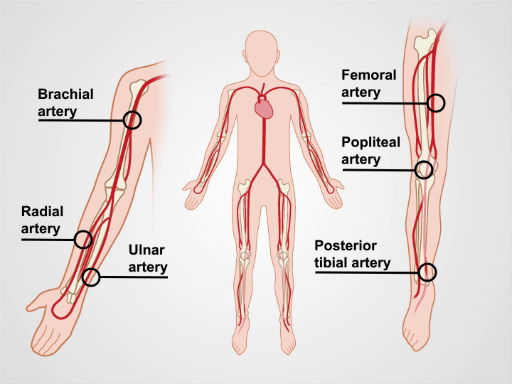Esame vascolare periferico utilizzando un Doppler a onda continua
Panoramica
Fonte: Joseph Donroe, MD, Medicina interna e pediatria, Yale School of Medicine, New Haven, CT
La malattia vascolare periferica (PVD) è una condizione comune che colpisce gli anziani e comprende la malattia delle arterie periferiche e delle vene. Mentre la storia e l'esame fisico offrono indizi per la sua diagnosi, l'ecografia Doppler è diventata una parte di routine dell'esame vascolare al capezzale. Il video intitolato "L'esame vascolare periferico" ha fornito una revisione dettagliata dell'esame fisico dei sistemi arterioso e venoso periferico. Questo video esamina in particolare la valutazione al posto letto della malattia arteriosa periferica (PAD) e dell'insufficienza venosa cronica utilizzando un Doppler a onda continua portatile.
Il Doppler portatile (HHD) è uno strumento semplice che utilizza la trasmissione continua e la ricezione di ultrasuoni (noto anche come Doppler a onda continua) per rilevare i cambiamenti nella velocità del sangue mentre scorre attraverso un vaso. La sonda Doppler contiene un elemento trasmittente che emette ultrasuoni e un elemento ricevente che rileva le onde ultrasoniche (Figura 1). L'ecografia emessa viene riflessa dal sangue in movimento e ritorna alla sonda ad una frequenza direttamente correlata alla velocità del flusso sanguigno. Il segnale riflesso viene rilevato e trasdotto in un suono udibile con una frequenza direttamente correlata a quella del segnale Doppler ricevuto (quindi, un flusso sanguigno più veloce produce un suono a frequenza più elevata).

Figura 1. Generazione di un segnale Doppler. Il Doppler portatile emette un segnale ecografico, che viene poi riflesso indietro dal sangue in movimento e infine ricevuto dalla sonda Doppler.
L'HHD è facilmente utilizzato in ufficio o in ospedale per rilevare gli impulsi, schermare la PAD utilizzando l'indice di pressione brachiale della caviglia (ABPI) e localizzare l'insufficienza venosa. Questo video esamina queste procedure; tuttavia, non intende essere una revisione completa dei test vascolari non invasivi.
Procedura
1. Preparazione
- Ottenere un bracciale per la pressione sanguigna, una macchina HHD, gel Doppler e marcatore cutaneo.
- Lavarsi le mani prima di esaminare il paziente.
- Inizia con il paziente in un abito, sdraiato comodamente supino sul tavolo d'esame.

Figura 2. Le principali arterie degli arti superiori e inferiori.
2.
Applicazione e Riepilogo
Un'attenta a storia e un esame fisico sono importanti per chiunque sia sospettato di malattia vascolare periferica in base a sintomi o fattori di rischio. L'HHD è diventato parte dell'esame vascolare di routine al capezzale e dovrebbe essere usato per integrare l'esame fisico, se si sospetta pvd. Non è uno strumento tecnicamente difficile da usare e le manovre descritte nel video possono essere eseguite da medici generici. Proprio come per l'esame fisico, la conoscenza dell'anatomia vascolare è fondamentale per il suc...
Vai a...
Video da questa raccolta:

Now Playing
Esame vascolare periferico utilizzando un Doppler a onda continua
Physical Examinations I
38.6K Visualizzazioni

Approccio generale all'esame obiettivo
Physical Examinations I
117.5K Visualizzazioni

Osservazione e ispezione
Physical Examinations I
95.0K Visualizzazioni

Palpazione
Physical Examinations I
84.5K Visualizzazioni

Percussione
Physical Examinations I
101.7K Visualizzazioni

Auscultazione
Physical Examinations I
62.2K Visualizzazioni

Adeguamento corretto dell'abbigliamento del paziente durante l'esame obiettivo
Physical Examinations I
83.4K Visualizzazioni

Misurazione della pressione sanguigna
Physical Examinations I
108.7K Visualizzazioni

Misurazione dei segni vitali
Physical Examinations I
114.9K Visualizzazioni

Esame obiettivo dell'apparato respiratorio I: ispezione e palpazione
Physical Examinations I
157.3K Visualizzazioni

Esame obiettivo dell'apparato respiratorio I: percussione e auscultazione
Physical Examinations I
212.9K Visualizzazioni

Esame obiettivo del cuore I: ispezione e palpazione
Physical Examinations I
176.6K Visualizzazioni

Esame obiettivo del cuore II: auscultazione
Physical Examinations I
140.1K Visualizzazioni

Esame obiettivo del cuore III: suoni cardiaci anormali
Physical Examinations I
91.9K Visualizzazioni

Esame obiettivo della vascolatura periferica
Physical Examinations I
68.8K Visualizzazioni
